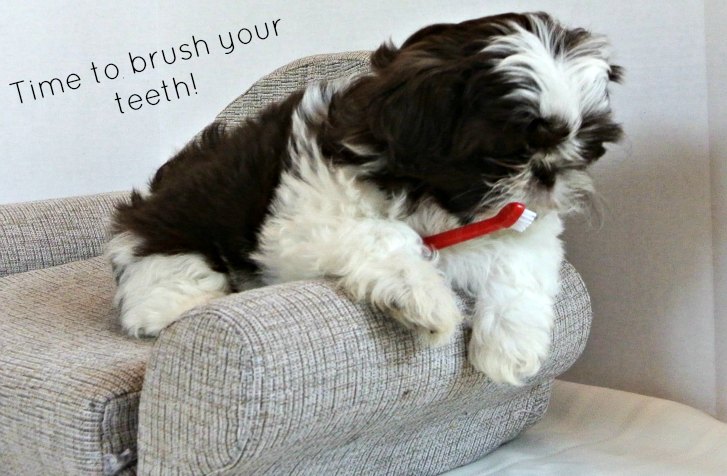-
Home
-
Small Dog Health
-
Puppy Dental Care
›
›
By Janice A. Jones | Last Updated 11-22-2021
Start off right with a puppy dental care plan. You’ll be glad you did, not only to keep those teeth shiny and breath smelling clean, but to also prevent costly dental visits to your vet later on.
A puppy is born toothless but development proceeds rapidly and by 6 or 7 weeks the teeth begin to come in. Some baby teeth erupt sooner. A puppy will keep these baby teeth until about the age of 4 or 5 months when they begin to lose them.

Start off right with a puppy dental care plan. You’ll be glad you did, not only to keep those teeth shiny and breath smelling clean, but to also prevent costly dental visits to your vet later on.
A puppy is born toothless but development proceeds rapidly and by 6 or 7 weeks the teeth begin to come in. Some baby teeth erupt sooner. A puppy will keep these baby teeth until about the age of 4 or 5 months when they begin to lose them.
Just like human babies, puppies lose their teeth gradually. By 3 months, some of the puppy’s incisors begin to fall out. You will begin to see the adult canine teeth and molars start to emerge.
By 7 to 8 months, all adult dog teeth have replaced the puppy teeth leaving the dog with a mouthful of 42 adult dog teeth. The lovely aroma of puppy breath disappears when the adult dog teeth replace the baby teeth.
Do not worry if you do not find any baby teeth because most of the time the puppy swallows them. This is not harmful and no cause for alarm.
Occasionally adult dog teeth come in where the baby teeth have not fallen out. In these cases, veterinarians will often remove the baby teeth during the time when the puppy is spayed or neutered.
One of the best ways to prevent dental problems is to get into a habit early of good puppy dental care even when the puppy still has his baby teeth. One of the best things you can do for your dog is to brush your dog’s teeth.
Years ago, it we believed that the main way to keep your dog’s teeth clean and sparkling was to feed a good kibble, supplement with dog biscuits and provide rawhide bones.
We now know that this is not enough –good puppy dental care can prevent tooth decay and bacterial infections from entering the bloodstream and causing great pain for your dog.
The more often you brush your dog’s teeth, the better, but you should brush at least once per day, and if that is not possible, that as frequently as you can.
When to Start Puppy Dental Care
Don’t wait until the adult dog teeth come in. Begin right from the start. Puppies need care too and it is never too early to start brushing their teeth. Start out with very short, positive session as soon as you obtain your dog.
Before you introduce a toothbrush, consider placing a small amount of doggie toothpaste on your index finger and massaging the puppy’s gums gently. Once puppy has accepted a human finger into his mouth, you are ready to introduce a tooth brush, finger brush, or wipe.
Puppies are squirmy and are likely to resist your efforts, so the first couple of sessions might consist of an introduction to the toothpaste and toothbrush. The puppy’s first reaction to tooth brushing is most likely going to be a propensity to chew on the brush.
As the puppy gets more accustomed to seeing the brush and paste, gently begin to go over his teeth, as you would your own, in a circular manner from the gums to the ends of the teeth.
It is usually easier to work on the side of the teeth closest to the gums and that is where most of the tarter accumulates.
Supplies You Will Need
Tooth Brush & Toothpaste
 |
Finger Brushes are Great for Puppies and any adult dogs that struggle with a regular toothbrush. Place the fingerbrush on your index finger, add a little toothpaste and massage their gums and teeth. In my experience, this is the easiest way to brush teeth. |
Additional Supplies to Keep Those Puppy Teeth Sparkling
|
This is a doggie favorite and it must taste great to dogs. (Sorry I’ve never sampled them). They make great treats that last lone and help improve bad breath while cleaning the teeth. |
 |
Puppy Dental Care: Brushing Those Tiny Teeth
Here is a video made by the DVM360 team that demonstrates the steps to take when brushing your puppy’s teeth.
Pointers for Brushing Puppy Teeth
- Go slow, starting with massaging the outside of the month and then the inside gums. Work your way up to the brush gradually over the next several weeks.
- Use a finger brush with a tasty toothbrush. Let your puppy lick the toothpaste.
- Work up to a small toothbrush, the smaller the better.
- Do not worry too much if you cannot get to the inside of the tooth.
- If you prefer, you can also use small gauze square sprinkled with a dab of toothpaste. This might be the easiest way to transition to the toothbrush because the puppy becomes accustomed to the taste of toothpaste.
Hints to Make Puppy Dental Care Easy
- Offer your puppy human treats such as veggie sticks or fruit. Puppies generally like carrot sticks, apples, or even raw green beans. Don’t force the issue if this isn’t on your puppy’s favorite foods list.
- Purchase dental chews and offer them as a treat. I like to give my dogs a dental stick when they go into their crates, either while I’m out or at night. My favorites are Greenies.
- Many dogs like hard biscuit treats. I prefer those that are of the same high quality as the dog food. These also help with teething puppies, but do not work well as a training treat.
- What about dental sprays? I’ve used several on dogs that just refuse any form of tooth brushing and they have worked for me moderately well. I personally do not think they replace teeth brushing, but that’s just my opinion.
Does This Article Deserve Your Thumbs Up?
We always appreciate your support and encouragement. Your thumbs up means so much to us. Please like this article.
If you find this page or any page on Small Dog Place Helpful, or Useful in anyway, I’d love it if you would click the small heart found on the bottom right of each page.
You can also share or bookmark this page — just click on the:

Free Monthly Newsletter
Sign Up for Our Free Newsletter and get our Free Gift to You.
my E-book, The Top 10 Mistakes People Make When Choosing a Dog (and how to avoid them)


